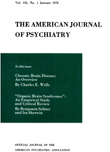GROUP TREATMENT OF CONDITIONALLY DISCHARGED PATIENTS IN A MENTAL HEALTH CLINIC
Abstract
Current literature has explored the possibilities of the use of the group approach to the treatment of state hospital patients who have been discharged to a mental health clinic for outpatient care. This paper deals with a method employed by a psychiatric team in the management of such patients. The rationale for the use of the group approach took a number of factors into account: 1) It is felt by some that a one-to-one relationship is particularly threatening for more severely ill patients. The group approach reduces the intensity of this relationship. 2) Some patients with ego weakness tend to acquire strength by identification with the group. 3) Patients in our groups are seen for a longer period of time than would normally be allotted to them during the brief, stereotyped, drug renewal interviews that usually constitute patient aftercare. 4) The group interaction offers a more variegated sampling of behavior on which to base clinical appraisals. 5) Seeing patients in groups is felt to be more efficient than seeing the same number of patients individually.
A psychiatric team used an approach employing an initial orientation meeting for an experimental sample of 45 conditionally discharged patients and their relatives, followed by monthly group treatment sessions for the patients. This experimental sample was compared with a control sample of 45 patients who did not receive group treatment, seen during the same time period and matched for age, sex, race, marital status and diagnosis.
The results of our study were obtained by comparing these two groups of patients for the following variables: return to hospital, significant at .05 level; receiving of absolute discharge, significant at .01 level; number of clinic contacts, significant at .01 level; mean number of months out of hospital, trend; chronicity, trend; employment after a year, not significant; receipt of medication, not significant.
We feel, therefore, that the findings of this study show that the group approach bears wider application in improving outpatient programs for an ever-increasing population of ex-hospital patients.
Access content
To read the fulltext, please use one of the options below to sign in or purchase access.- Personal login
- Institutional Login
- Sign in via OpenAthens
- Register for access
-
Please login/register if you wish to pair your device and check access availability.
Not a subscriber?
PsychiatryOnline subscription options offer access to the DSM-5 library, books, journals, CME, and patient resources. This all-in-one virtual library provides psychiatrists and mental health professionals with key resources for diagnosis, treatment, research, and professional development.
Need more help? PsychiatryOnline Customer Service may be reached by emailing [email protected] or by calling 800-368-5777 (in the U.S.) or 703-907-7322 (outside the U.S.).



